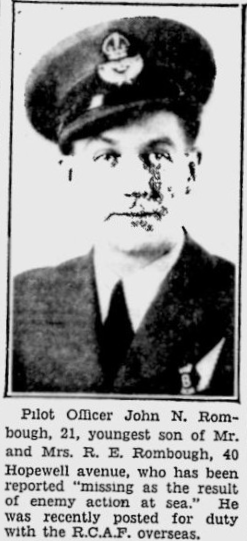


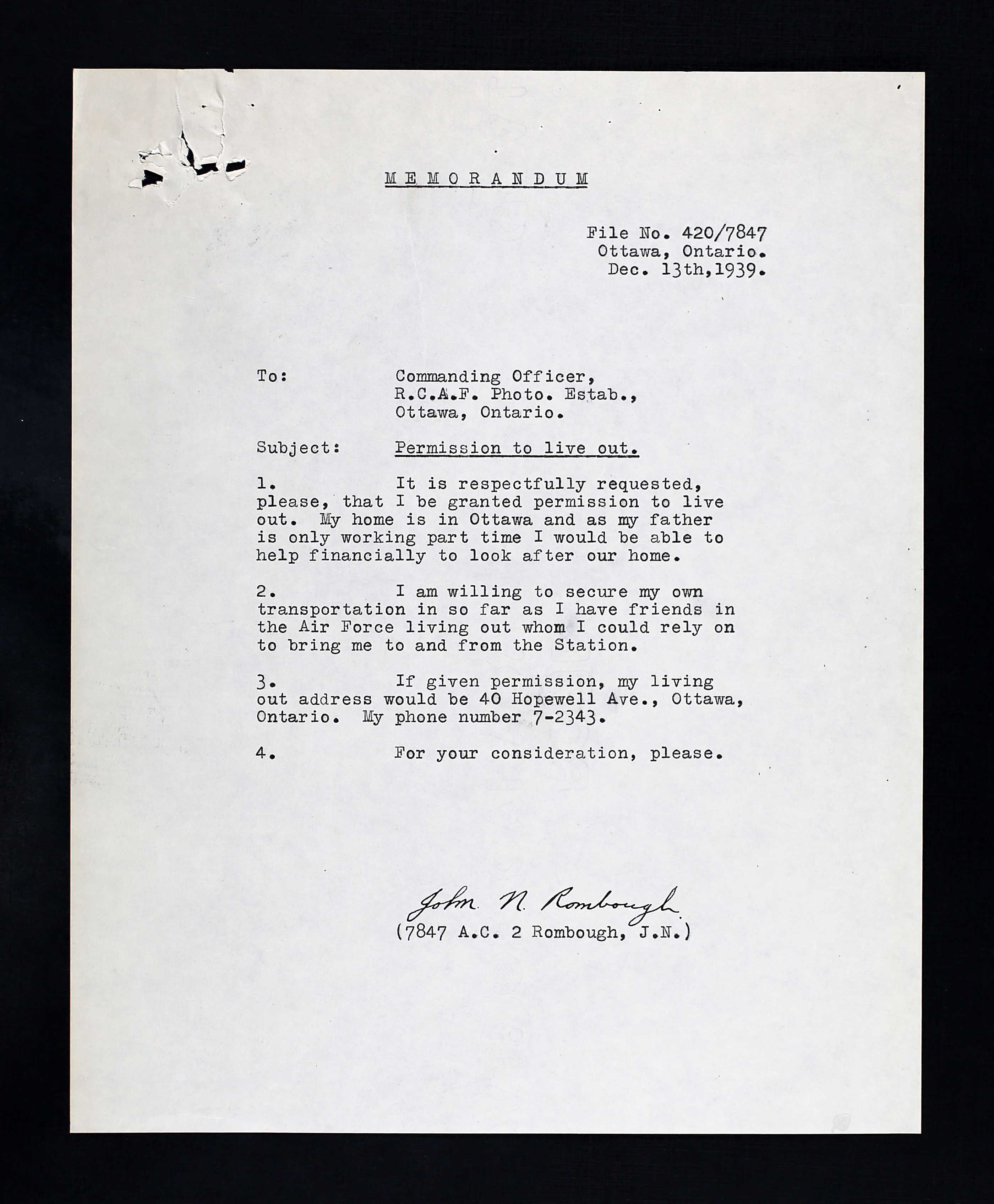

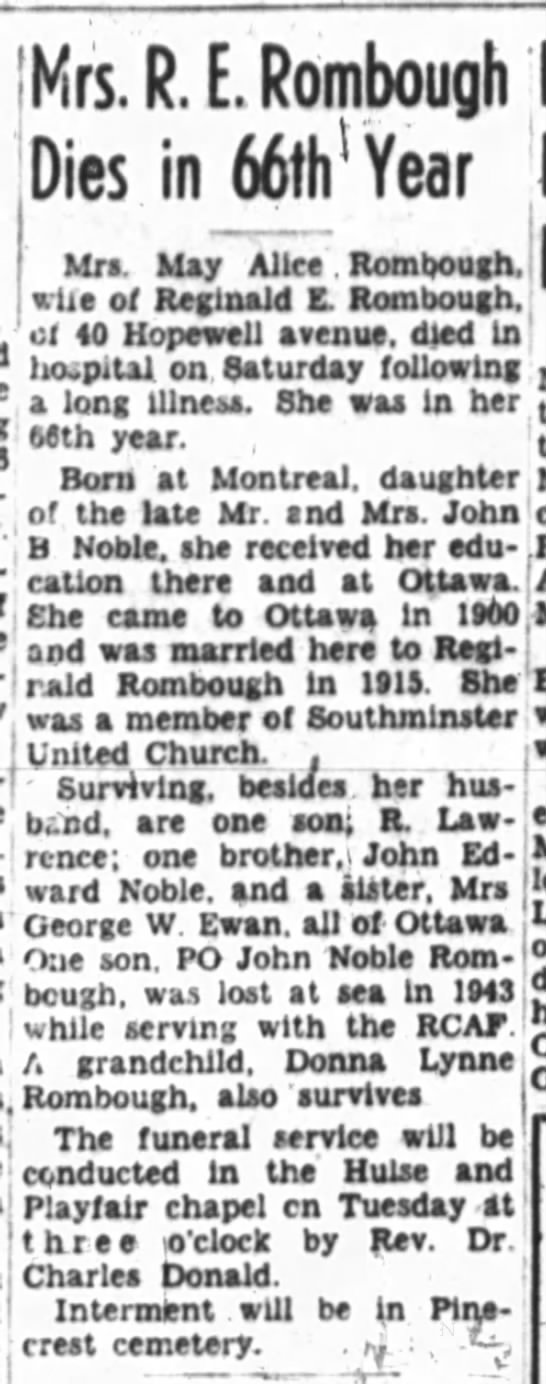
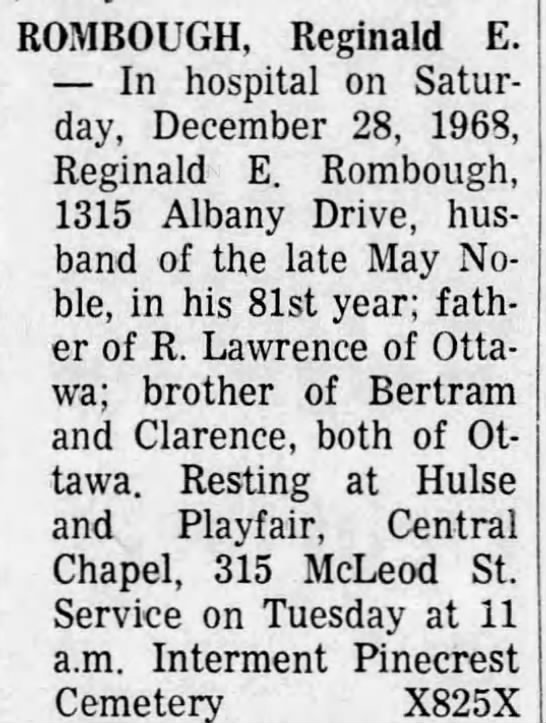
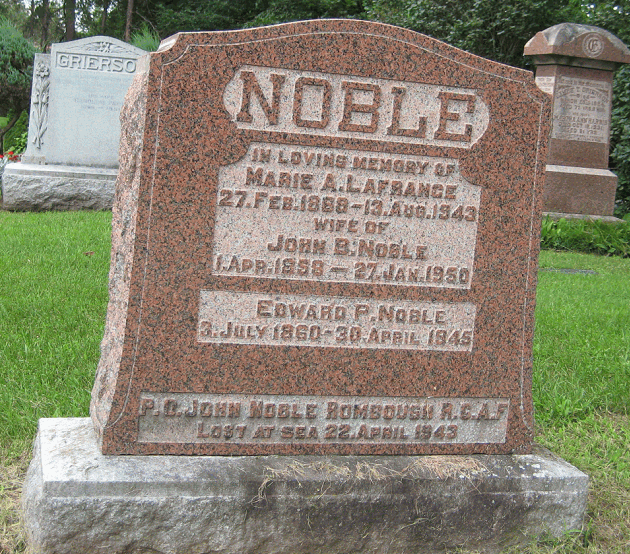
May 31, 1921 - April 22, 1943








John Noble Rombough was the son of Reginald Elwood Rombough (1888-1968), inspector of the G. T. Railway, and Alice May (nee Noble) Rombough (1889, 1953, of 40 Hopewell Avenue, Ottawa. He had one older brother, Benjamin Lawrence, who enlisted with the RCAF, who seems to have remained with the RCAF through to at least 1953.
He attended Hopewell Public School, then Glebe Collegiate, earning a Junior Matriculation by 1938. He then went to Stephen T. Willis College of Commerce, January to September 1939 to learn typing and shorthand. He worked as a delivery boy for a tailor for six months.
John enlisted in Ottawa on September 16, 1939 and thought he would be a candidate for a clerk with the RCAF. “Shorthand very good. Typing a bit slow, but accurate. Will improve with practice.”
John stood 5’8” and weighed 143 pounds. He had blue eyes and brown hair, with a scar on his right knee noted.
The RCAF accepted John as a clerk and he remained in the Ottawa area, at Rockcliffe, connected to the Photography Establishment located there. He received superior evaluations on his proficiency and and exemplary assessment of his character. “Has a very good grasp of his work.” Other comments: “This NCO is smart in personal appearance at all times. There is no criticism of his personal habits possible. A good administrative NCO who pays attention to detail.”
John requested that he live at home while working in Ottawa, as his father worked part time and John would be able to help his family financially to look after their home. He was willing to secure his own transportation.
While at Rockcliffe, John was at the hospital from May 21 – 27, 1941. He donated blood three times: July 29, 1941, December 22, 1941, and April 23, 1942.
In July 1942, John remustered. “This NCO is anxious to remuster and is quite willing to revert to basic rank necessary. His habits are exemplary, and he is strongly recommended.” Other comments: “Junior Matriculation education, plus some upper school work and a pre-entry air crew education course. Applicant shows average ability to learn. Personal background satisfactory. Two years, eight months in RCAF Service as Clerk Administrative.” The Interviewing officer noted, “Applicant 34 months in Servce. Should make excellent Aircrew ITS material. Well-mannered and groomed. Has pleasing personality.” The medical officer noted: “Ocular accommodation unsatisfactory for pilot.”
John started his training at No. 5 ITS Belleville, Ontario from September 14 to November 7, 1942, earning an 82%.
He then went to No. 4 B&G School, Fingal, Ontario to an Air Bomber’s Course from November 23, 1942 to February 5, 1943, with a 78.14%, second in his class.
From there he went to No. 9 Air Observer’s School, at St. Johns, Quebec from February 8 to March 19, 1943 where he passed with 79.2% and earned his Air Bomber’s Badge.
By April 4, 1943, John had traveled across the country and arrived at Y Depot, Halifax, awaiting transport overseas. Here he filled out a form confirming his parents’ names and address and indicated he would like to remain in the RCAF after the war ended.
Sometime later, he, with 36 other RCAF airmen, boarded the Amerika. On April 22, while on its way from Halifax, Nova Scotia to Liverpool, it was torpedoed as the ship was heading to Britain. It was a straggler in convoy HX-234. Thirty-seven men, all officers in the RCAF, were presumed missing as a result of enemy action at sea including Thomas. Their ship was sunk by U-306, south of Cape Farewell, off Greenland.
Forty-two crew members and seven gunners were also amongst those who were lost. The master, Christian Nielsen, 29 crewmembers, eight gunners, and sixteen passengers (RCAF airmen) were picked up by the HMS Asphodel, and landed at Greenock. General cargo, including metal, flour, meat and 200 bags of mail were also lost.
Mr. Rombough received a letter dated June 25, 1943 from F/L W. R. Gunn, RCAF Casualties Officer for Chief of the Air Staff. "Since my letter of May 6th, no additional news has been received. Attached is a list of the names and next-of-kin of sixteen Royal Canadian Air Force officers who embarked on the same ship as your son and following enemy action at sea were safely landed in the United Kingdom. The following official statement was made in the House of Commons....’I have been in receipt of communications from a number of members of this house and from people outside with reference to rumours regarding the recent loss of a number of members of the RCAF by the sinking of a ship in the north Atlantic and I desire to make the following statement on the facts. The vessel in question was a ship of British registry of 8,862 tons, designed for peace-time carriage of both passengers and freight, and having a speed of fifteen knots. She carried a crew of 86 and the passenger accommodation consisted of 12 two-berth rooms with bath and 29 other berths, providing cabin accommodations for 53 passengers. She was fitted with lifeboat capacity for 231 and travelled in naval convoy. Under the recently revised regulations agreed to by the United States authorities, the joint United Kingdom and United States shipping board, the Admiralty, the Air Ministry and the Canadian authorities, a vessel of this description travelling in convoy is permitted to embark as crew and passengers a maximum of 75% of the lifeboat capacity. The lifeboat capacity as stated above was 231, 75% of which is 173. Personnel on board consisted of the crew of 86, and RCAF personnel numbering 53, a total of 139, well within the prescribed limits. Because of the superior type of available passenger accommodation, the speed of the ship and the provision of naval convoy, the offer of the entire available space to the RCAF was immediately accepted. Rumours to the effect that this was a slow freighter not suitable for passenger accommodation are, of course, not in accord with the facts. Every precaution was taken to safeguard the lives of these gallant young men. It should be pointed out that on account of the serious shipping shortage every available berth on such ships must be used, and had the space not been taken up by the RCAF officers of the other arms of the services would have been placed on Board. It should also be stated again that the submarine is still the enemy’s most powerful weapon and that the Battle of the Atlantic is not yet won. Any ocean trip today in any part of the world is fraught with danger and I think I may safely say that our record in transporting our soldiers and airmen to the United Kingdom is one of while we may all be proud. No one deplores more than I do the loss of 37 of the finest of our young men who gave their lives for their country as surely as if they had done so in actual combat with the enemy, and I extend my deepest sympathy to their loved ones in their bereavement.’ If further information becomes available, you are to be reassured it will be communicated to you at once. May I again extend to you my sincere sympathy in this time of great anxiety."
In early January 1944, John’s mother received another letter from S/L W. R. Gunn that John would now be presumed dead for official purposes.
In late September 1945, a memo from the RCAF stated that because John had less than twenty years pensionable service, he could not have qualified for pension prior to his death, no pension dues were contributed during his service and no entitlement existed either to pension or gratuity under the Militia Pension Act in respect of any dependents who survived him.
John did not have any savings, nor bonds or insurance. Mr Rombough wrote, “Previous to enlisting, my son was a student at Glebe Collegiate and therefore never accumulated any assets. He had all his personal belongings, including a very good watch, a ring, and perhaps $200 in cash on his person, together with his clothing, toilet articles, etc. when lost at sea. He mentioned he was buying a Victory bond on the installment plan through the RCAF, but as to denomination and amount he had paid on some, I cannot say.”
In October 1955, a letter addressed to Mr. Rombough arrived from W/C W. R. Gunn informing him that Thomas’s name would appear on the Ottawa Memorial, as John had no known grave, expressing sympathy on the loss of her gallant son. Mrs. Rombough passed away in October 1953. It is unknown if Mr. Rombough visited the memorial.